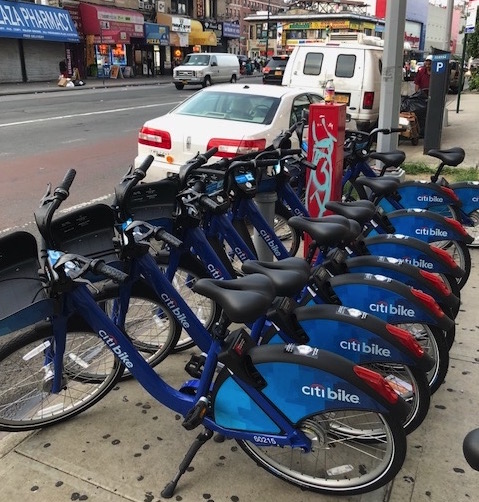A Hit-and-Miss Debut for Dockless Citi Bikes in the Bronx
On day one, the dockless Citi Bikes didn't always work like they're supposed to.

Citi Bike launched in the Bronx yesterday with a small fleet of dockless bicycles and a lot of asterisks. The company’s dockless offering has a ton of potential but is not yet a reliable bike-share service, judging by my spot checks and test rides after the launch party at Tuff City Tattoos.
Because the de Blasio administration is testing out dockless bike-share this year instead of adding more Citi Bike stations, the Bronx Citi Bike zone is disconnected from the main service area, which doesn’t extend north of 130th Street in Manhattan.
By next week, Motivate, the company that runs Citi Bike, expects to have 200 bicycles on the street in the area roughly between Bronx Park and the Harlem River. For now, these neighborhoods are getting an experiment in dockless Citi Bike, not access to bike-share that serves as a viable option for many types of trips.
Karla Cabrera, a graduate student at Baruch College who lives on the Grand Concourse, goes for the occasional Citi Bike ride with friends when she’s in Manhattan or Brooklyn. She came to the launch party because she was curious about how the dockless Citi Bikes work, but she thinks the pilot zone is too small to benefit her. “If I was trying to use it to get from point A to point B, it wouldn’t make much sense,” she said.

Still, the dockless Citi Bike pilot could be the prelude to something big. Motivate can hypothetically use dockless bikes to expand more rapidly in New York and other major cities where it operates bike-share systems. Spokesperson Julie Wood indicated that the company envisions expanding Citi Bike with a hybrid system that still adds docking stations while also taking advantage of the flexibility of dockless bikes.
But first the experiment has to work well, and on day one, the dockless Citi Bikes were hit and miss.
My first attempt to unlock a Citi Bike at the launch party went off without a hitch. To unlock the rear wheel of the bikes, you open the Citi Bike app, touch the “unlock dockless bike” prompt in the app, and tap your phone on a sticker with a phone icon (there’s one on the rear fender and another between the handlebars). A 30-minute trip is no extra cost for Citi Bike members, $2 for non-members. If you park outside the borders of the pilot zone, it’s a $20 fine.
I biked around the block and it was the same smooth, sturdy ride that built Motivate’s reputation for high-quality bike-share fleets. I closed the trip without incident by locking the rear wheel.
Then I tried a few other bikes that didn’t unlock, which a Motivate staffer attributed to poor wireless connectivity. Spotty connections also explain why the Citi Bike app did not accurately display the location of bicycles. Several bikes that appeared in the app turned out to be phantoms in real life. (Similar problems are common with other dockless systems. While I was in the Bronx bike-share zone, the JUMP app displayed no bikes at all.)

The first dockless Citi Bike I found in the wild, by St. Barnabas Hospital, did unlock without any trouble. I rode over to Webster Avenue and parked it on the sidewalk by a cache of other Citi Bikes. I locked the rear wheel, which should have closed the trip but didn’t — the trip timer in the app kept counting upwards. I called customer service to close the trip, and a Citi Bike rep said the trouble was due to a wireless “dead zone.” That would explain why none of the Citi Bikes where I parked showed up in the app.
I asked Motivate for an explanation of the bugs and what’s being done to address them, but the company didn’t offer details. “We will be continuously working to upgrade our dockless technology as well as providing excellent customer service and operations so riders can enjoy the bikes,” said a spokesperson. “In the less than 24 hours since launch, we’ve already seen nearly 100 rides.”
And on the nuts and bolts of maintenance and operations, it’s certainly true that Motivate isn’t skimping on this pilot zone. The company has four mechanics assigned to the area, two rebalancers who can haul six to eight Citi Bikes at a time on bike trailers, and three bilingual “ambassadors” getting the word out in a part of the Bronx where most residents speak Spanish.
Some level of glitchiness is also to be expected in the beginning. Part of the rationale for rolling out dockless bike-share with small pilots is to identify and correct these types of bugs before moving on to a larger scale. But these connectivity problems will need to get fixed if dockless Citi Bike is going to have legs.
The expansion of Citi Bike — whether it’s with stations, dockless bikes, or a combination — remains the surest way to bring useful bike-share service to New York City neighborhoods that currently lack it. The people who came out to the launch party expect no less.
Troy Dixon, a community coordinator for NYCHA who runs programs for youth and seniors, sees bike-share as an affordable way to integrate physical activity into people’s lives. He wants to use bike-share for group rides that bring the older people and the younger people he works with together. “Once people understand how important it is, I think they will have to bring more bikes to the Bronx,” he said.




